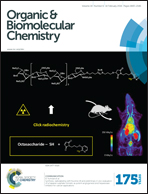Target-specific identification and characterization of the putative gene cluster for brasilinolide biosynthesis revealing the mechanistic insights and combinatorial synthetic utility of 2-deoxy-l-fucose biosynthetic enzymes†
Abstract
Brasilinolides exhibiting potent immunosuppressive and antifungal activities with remarkably low toxicity are structurally characterized by an unusual modified 2-deoxy-L-fucose (2dF) attached to a type I polyketide (PK-I) macrolactone. From the pathogenic producer Nocardia terpenica (Nocardia brasiliensis IFM-0406), a 210 kb genomic fragment was identified by target-specific degenerate primers and subsequently sequenced, revealing a giant nbr gene cluster harboring genes (nbrCDEF) required for TDP-2dF biosynthesis and those for PK-I biosynthesis, modification and regulation. The results showed that the genetic and domain arrangements of nbr PK-I synthases agreed colinearly with the PK-I structures of brasilinolides. Subsequent heterologous expression of nbrCDEF in Escherichia coli accomplished in vitro reconstitution of TDP-2dF biosynthesis. The catalytic functions and mechanisms of NbrCDEF enzymes were further characterized by systematic mix-and-match experiments. The enzymes were revealed to display remarkable substrate and partner promiscuity, leading to the establishment of in vitro hybrid deoxysugar biosynthetic pathways throughout an in situ one-pot (iSOP) method. This study represents the first demonstration of TDP-2dF biosynthesis at the enzyme and molecular levels, and provides new hope for expanding the structural diversity of brasilinolides by combinatorial biosynthesis.


 Please wait while we load your content...
Please wait while we load your content...